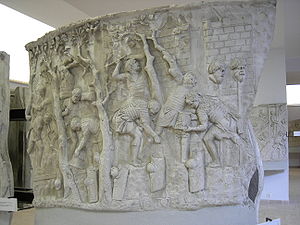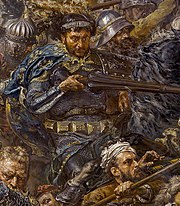the ancient history of Poland would basically go into ancient slavic history and mythology....
Not necessarily if we take `pro et contra` political reasons for discussion about ancient past of Poland. But, if we insist to operates with scientific and historic facts, that's how it is.
And, again, we are aware of politics. Why, in this particular case?
It's because, scientific facts and historic truth, almost same as falsified history, could be objects of manipulations in order to satisfy some political goal, interests of some political elite, etc, etc. [BDW, it also can be good fun]
So, we should avoid all eventual traps in our journey through Polish and Slavic past in general. We must be aware that Slavic history was too often written by those who conquered Slavs and, seams that we also must be aware of political consequences of truth. Here, transparency and public discussion could help (God bless internet!).
I vote for truth in case with Slavic (Polish) past so that our young generation's could learn and remember. Without knowledge about our own past, we can't avoid same mistakes. Not to mention, that serious examination of Slavic past can open real new frontiers in case with our knowledge of universal human past. Our past, our present, our future, all is our contribution to our kind and then to complete mankind. All counts
I wonder, if you ever heard for
Sarmizegetuza?
Do we have time to remind ourselves of Sarmizegetuza for a moment, in this modern and so fast era?
Sarmizegetuza should be remembered from all Sarmatians, so i would speak about that place here, in this thread dedicated to ancient times.
It was place in today`s Romania. But, before Romania those lands were part of Sarmatia, more concrete, there was Dacia and Dacians, children of Slavia. Sarmizegetuza was capital of Dacia.
This is story about time, when population of Dacia was slain almost entirely to ground zero and replaced with new settlers with different ethnic and even different racial characteristics. That`s how branch of Sarmatians was exterminated, some of them managed to escape and some were romanized.
Let fallen Sarmatians rest in peace. Their resistance should be remembered and mentioned...
 Roman soldiers building a bridge and a mountain road in Dacia, from Trajan's Column. Note the heads on pikes at the right.Battle of Adamclisi
Roman soldiers building a bridge and a mountain road in Dacia, from Trajan's Column. Note the heads on pikes at the right.Battle of Adamclisien.wikipedia.org/wiki/Battle_of_Adamclisi
Battle of Adamclisi was a major battle , in 92 AD when a coalition of Dacian and Rhoxolani sarmatian completely slaughtered the Legio XXI Rapax[1]
Dacian king benefited from this, and made out a plan along with the neighboring allied tribes of the Roxolans and Bastarnae, to attack south of the Danube, in the Roman province of Moesia, in an attempt to force the Romans to leave their positions in the mountains near Sarmizegetusa.
First Battle of Tapaeen.wikipedia.org/wiki/First_Battle_of_Tapae
Two battles took place at Tapae under the Roman Emperor Domitian in order to protect the Roman province of Moesia, nearly two decades before the regional conquest during the Dacian wars in Trajan's reign, one in 87 AD and one in 88 AD.
Second Battle of Tapaeen.wikipedia.org/wiki/Second_Battle_of_Tapae
The Roman army crossed the Danube at Viminacium, slowly making its way into Dacia. Just like in 87/88, the battle took place at Tapae. The Dacians resisted the Roman offensive, but as a storm broke out, the Dacians believing it is a sign from the Gods, decided to withdraw.
Battle of Sarmisegetusaen.wikipedia.org/wiki/Battle_of_Sarmisegetusa
The Battle of Sarmisegetusa (also spelled Sarmizegethusa) was a siege of Sarmizegetusa, the capital of Dacia, fought in 106 between the army of the Roman Emperor Trajan, and the Dacians led by King Decebalus.
The Roman forces approached Sarmizegetuza in three main columns. The first column crossed the bridge built by Apollodorus of Damascus, and then followed the valleys of rivers Cerna and Timiş up to Tibiscum. They then turned on the valley of the river Bistra, through the Tara Hategului depression.
NOTE: names of rivers
Dacian treasure which, according to Jerome Carcopino (p.73), consisted of 165,000 kilograms of pure gold and 331,000 kilograms of silver in the bed of the Sergetia River (Cassius Dio 68.14).
Losses sustained in this war by the Dacians were tremendous, but the Roman army also took significant casualties in the conquest of Dacia. The first Dacian rebellion against Roman rule would coincide with the death of Trajan, in 117, showing impact the Emperor had on the Dacians after the war. Even in modern Romanian folklore (Romanians being the descendants of Romanized Dacians),...
most glorious episode from Polish past by my choice
Thanks Poles for this victory!
THE BATTLE OF GRUNWALD Jan Matejko. The Battle of Grunwald. 1878
Jan Matejko. The Battle of Grunwald. 1878The battle was furious. The incessant clash of swords was like the rolling of thunder across a field. Horses whinnied and went down, throwing their masters under the hooves of other horses, and a wild confused and terrible hand-to-hand battle raged inconclusively for nearly half an hour.
HENRYK SIENKEWICZ, "Krzyzacy":Many things have happened over the centuries - battles and meetings - but no one can remember such a terrible crushing defeat. It fell under the eyes of the Great King Jagiello, not only the Teutonic Order but the whole of Germany, whose greatest knights were in the front line of the Teutonic Order, which was more and more entering to the Slavic land...
on Polish:
Wiele bywalo w owych czasach na swiecie bitew i spotkan, ale nikt z zywych ludzi nie pamieta tak straszliwego pogromu. Padl pod stopami wielkego Krola nie tylko Zakon krzyzacki; ale i cale Niemcy, ktore najswietniejszym rycerstwem wspomagaly ona "przednia straz" teutonska, wzerajaca sie coraz glebiej w cialo slowianskie...
more about Zawisza Czarny, who taken part in Battle of Grunwald (read in text/link above)...
Zawisza Czarnyborn in Poland, dedicated whole life to freedom of Slavdom, gave his honorable life in Serbia, for liberation of Racowieen.wikipedia.org/wiki/Zawisza_Czarny
 Zawisza Czarny in a detail of Jan Matejko's Battle of Grunwald
Zawisza Czarny in a detail of Jan Matejko's Battle of GrunwaldZawisza Czarny z Garbowa (Zawisza the Black of Garbów, also known as The Black Knight; c. 1379 in Stary Garbów, Poland - 1428 in Golubac, Serbia), Sulima Coat of Arms, was a famous Polish mediæval knight and diplomat.
...in 1428 during the Battle of Golubac on the Danube (Serbia) he was captured by the Turks and probably murdered.
Zawisza became for many Poles one of the most popular folks heroes thank to his exceptional bravery and proverbial reliability and loyalty. Famous is the Polish saying: "Polegaj jak na Zawiszy" (Rely on him like on Zawisza). This motto also became part of the Polish Scouts oath.
memorial table and water pool dedicated to Zawisza Czarny in Serbia, banks of Danube River, old medieval fortress, where once Racowie were recruited to be sent to serve PolandFor all the Poles, a monument to Zawisza Czarnytext on the table says (translation from Serbian):
``In Golubac, his life was taken by the Turks in 1428, the famous Polish knight, the symbol of the courage and honor, Zawisza the Black. Glory to the hero!``
I thought this could be interesting for Poles here. Wanted to show you this later, in step by step elaboration but, considering that many of my posts here are deleted i giving this now as my last post in this thread...
Appendix 2, part 12: GENETIC HOMOGENEITY IN POLANDPloski R, Wozniak M, Pawlowski R, Monies DM, Branicki W, Kupiec T, Kloosterman A, Dobosz T, Bosch E, Nowak M, Lessig R, Jobling MA, Roewer L, Kayser M.
Human Molecular Genetics Lab, Department of Forensic Medicine, Warsaw Medical Academy, PolandHum Genet. 2002 Jun;110(6):592-600. Epub 2002 May 2white-history.com/poland.htm]
The relative homogeneity and lack of outside or non-European influence in Poland has been confirmed by genetic research
 PolishForums LIVE / Archives [3]
PolishForums LIVE / Archives [3]







